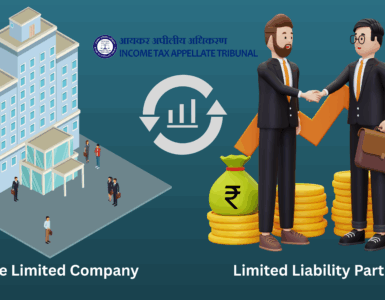Introduction
Section 50B of Income Tax Act, 1961 deals with the taxability of profits arising on transfer of any business. Sub-section (1) of Section 50B provides that “any profits or gains arising from the slump sale” shall be chargeable to income tax as capital gain. The term “Slump Sale” has been defined in Section 2(42C) of the Income Tax Act as the transfer of one or more undertakings by any means for a lumpsum consideration without values being assigned to the individual assets and liabilities in such sales.[1]
Further, the term “undertaking” has been defined for this purpose in Explanation 1 to Section 2(19AA) of the Act as under:- “For the purposes of this clause, “undertaking” shall include any part of an undertaking, or a unit or division of an undertaking or a business activity taken as a whole but does not include individual assets or liabilities or any combination thereof not constituting a business activity.”
In case, sale consideration has been determined on the basis of individual assets not lumpsum basis, neither the sale can be considered to be sale of undertaking nor it would be in the nature of slump sale and therefore, provisions of Section 50B will not be applicable and business profit or capital gain will be chargeable to tax on the basis of sale of each of the assets.
Before amendment by the Finance Act, 2021, Section 50B (2)[2] was only looking at arriving at the cost of the undertaking being transferred and not fair value of The undertaking which is to be considered as sale consideration. Now it has been substituted by newly inserted sub-section (2) which reads as under: –
“(2) In relation to capital assets being an undertaking or division transferred by way of such slump sale, –
- the “net worth” of the undertaking or the division, as the case may be, shall be deemed to be the cost of acquisition and the cost of improvement for the purposes of sections 48 and 49 and no regard shall be given to the provisions contained in the second proviso to section 48;
- Fair market value of the capital assets as on the date of transfer, calculated in the prescribed manner, shall be deemed to be the full value of the consideration received or accruing as a result of the transfer of such capital asset.”
The following Explanation also inserted with respect to take value of goodwill:
“In the case of capital asset being goodwill of a business or profession, which has not been acquired by the assessee by purchase from a previous owner, nil;’’.
As far as net worth is concerned, new subsection (2) is exactly same as earlier one so there is no change in the working to arrive at the cost of the undertaking for calculating capital gain under this section and as required now also, for cost certificate from the chartered accountant in form no. 3CEA.
For the purpose of arriving the sale consideration for the purpose capital gain, calculation of Fair Market Value under section 50B(2) rule 11UAE has been inserted in the Income Tax Rules, 1962 by Notification dated 24.05.2021. The effect of Rule 11UAE is being discussed herein.
Fair market value is higher of:
FMV1: Derived based on Net adjusted assets method.
FMV2: Calculation based on consideration (Both Monetary and Non-monetary) received or accrue to seller.
For FMV1 and FMV2 refer Annexure below.
Why this Amendment?
There were different opinions on the applicability of Section 50B in case of consideration is not discharged in cash. As per the decision in case of Bharat Bijlee, the provisions of section 50B will not be applicable where consideration is received in the form of other than cash i.e. shares/securities etc. Post-decision, many corporates were talking about the shelter of case by discharging the consideration in shares or otherwise and thereby not paying any direct tax on such transfer. This practice was common while transferring the business between group entities. To tax such transactions, Finance Act, 2021 amended the definition of Slump Sale and Section 50B.
Applicability
Section 50B(2) has been inserted with effect from 01.04.2021. The sub-section provides for determination of fair market value of specified assets in the prescribed manner. Rule 11UAE has been notified on 24.05.2021. The issue, therefore, arises from which assessment year the amended provisions will be applicable. It is stated in this regard that amended provisions cannot apply to Assessment Year 2021-22 because there was no prescribed manner in the relevant previous year and even as on 01.04.2021. Moreover, sale of undertaking, which has already taken place in the year ended 31.03.2021 cannot be subject to amended provisions.
The term “Slump Sale” for the purpose of Section 50B is defined in Section 2(42C) and is specifically refers to transfer of one or more undertaking for a lumpsum consideration without values being assigned to the individual assets and liabilities. Clause (ii) of Sub-Section (2) of Section 50B is contrary to the definition of “Slump Sale” and also the definition of “Undertaking” given in Explanation 1 of Section 2(19AA) of the Act. Above referred Explanation also specifically provides that undertaking refers to whole of the business activity and not individual asset or liability. Therefore, determination of fair market value based on individual assets is contrary to the scope of provisions of Section 50B of the Act.
The issue of whether a particular transaction is to be considered as a slump sale or an itemized sale view is that if the sale consideration has been arrived at by adding up the value of individual assets, then the transaction may be considered as itemized sale of assets and not slump sale. If the sale consideration is based on some other method (i.e., specifically not taking the value of individual assets into account), then the transaction may be considered as slump sale. (Based on decisions)[3]
While executing any slump sale transaction, drafting of Business Transfer Agreement becomes extremely important/carefully as small wording can colour slump sale transaction to Itemized sale.
Slump Sale or Itemised sale — which is better?
Subject to levy of GST (Goods and Services Tax) and other taxes, one may evaluate whether itemized sale of assets or slump sale would be more beneficial. It would be worthwhile to evaluate this specially in cases where there is a cashflow constraint, depreciable assets (in case of difference in Tax WDV and book WDV). In such cases, itemized sale of assets may prove to be more beneficial. Further, if one of the assets of the undertaking is not subject to income tax (e.g., agricultural land), itemized sale may prove more beneficial than slump sale.
In case of itemized sale, one needs to keep in mind any implications under section 50C or 50CA and section 56(2)(x) or Section 43CA. In case of slump sale, view can be taken as these sections will not be applicable as the transfer is of an “Undertaking”.
Other option available in case Slump sale is not feasible.
If companies want to transfer undertaking to Wholly Owned Subsidiary (WoS), then instead of doing slump sale, one can also evaluate the possibility of transferring “Undertaking” without consideration to WoS. Recently, Cipla Limited filled a similar scheme with Hon’ble Mumbai NCLT (National Company Law Tribunal).
Conclusion
Finance Act, 2021 brought plethora of changes to “Slump Sale”. While the changes are retrospective, recent notification on rule remain silent on the effective date. Slump Sale is common mode of restructuring for most of the internal restructuring as it gives several advantages over other modes to the acquirer i.e. i) it saves time and ii) can record assets at fair value for tax claim though it may not be as favourable to the seller as consideration is received by the company and tax payable for the sale transaction can be higher. To date, this was being taken care by the seller through innovative structuring to enhance value for both the parties as Sec 50B did not provide for the mechanism (other than cash transaction) to determine the sale consideration and rules for its valuation. In pursuant to the recent sea changes, groups will re-consider the option of slump sale and may opt for some other modes like demerger. Going ahead, Slump Sale will significantly increase the cost if the major part of “Undertaking” consists of immovable property, or shares etc. There are likely to be limited impact on external re-structuring.
In the end, commercials of the transaction will continue to prevail over mode of transaction be it internal or external.
Annexure: FMV1 and FMV2
Calculation of FMV1
| FMV1 which is derived based on adjusted net assets transferred | |||
| A | |||
| i | Book Value of all assets* (other than jewellery, artistic work, shares, securities and immovable property) | xxx | |
| Less: | |||
| ii | Income-tax paid less the amount of income-tax refund claimed | (XXX) | |
| iii | Miscellaneous Exp/deferred expenditure which does not reflect value of assets | (XXX) | |
| Net (i-ii-iii) Total | XXX | ||
| *Value of self-generated goodwill taken as ‘Nil’. However, value of purchased goodwill is considered./em> | |||
| B | |||
| Market value jewellery and artistic work | XXX | ||
| Total | XXX | ||
| C | |||
| Fair market value of shares and securities (Determined according to rule 11UA (1) | XXX | ||
| Total | XXX | ||
| D | |||
| Stamp duty value of Immovable property | XXX | ||
| Total | XXX | ||
| L | |||
| Book Value of liabilities | XXX | ||
| But does not include | |||
| i | paid-up capital in respect of equity shares | ||
| ii | amount set apart for payment of dividends on preference shares and equity shares where such dividends have not been declared before the date of transfer at a general body meeting of the company | ||
| ii | Reserve and surplus | ||
| iii | provision for taxation | ||
| iv | provisions made for meeting liabilities, other than ascertained liabilities | ||
| v | contingent liabilities other than arrears of dividends payable in respect of cumulative preference shares | ||
| Total | XXX | ||
| FMV1 (A+B+C+D-L) (Net adjusted assets) | XXX | ||
Calculation of FMV2:
| FMV2 which is derived based on consideration receive or accrue on transfer of undertaking to seller | ||
| E | ||
| Value of the monetary consideration received or accruing as a result of the transfer | XXX | |
| Total | XXX | |
| F | ||
| Fair market value of non-monetary consideration received or accruing as a result of the transfer (Which covered in rule 11UA (1)) Value determined according to rule 11UA (1) e.g., shares & securities, Jewellery, drawing painting. |
XXX | |
| Total | XXX | |
| G | ||
| the price which the non-monetary consideration received or accruing as a result of the transfer represented by property, other than immovable property (Not covered in Rule 11UA (1) Valued at market value based on valuation report from registered valuer. e.g., Like in Dhamapur Sugar Mills consideration paid in kind for licences fee. |
XXX | |
| Total | XXX | |
| H | ||
| Stamp duty value of Immovable property | XXX | |
| Total | XXX | |
| FMV2 (E+F+G+H) | XXX | |
[1] Amended by FA 2021. Effective from AY 1-4-2021
[2] The provision of section 50B (2) is effective from AY 1-4-2021 (i.e., FY 2020-21). However, rule is notified 24th May 2021.
[3] CIT v. Electric Control Gear Mfg. Co. [1997]
CIT v. Artex Engg. Co. [1997]





Add comment